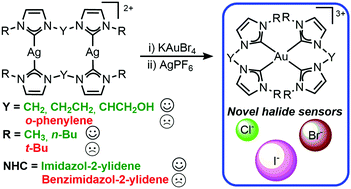当前位置:
X-MOL 学术
›
New J. Chem.
›
论文详情
Our official English website, www.x-mol.net, welcomes your
feedback! (Note: you will need to create a separate account there.)
New homoleptic gold carbene complexes via Ag–Au transmetalation: synthesis and application of [Au(diNHC)2]3+ cations as 1H-NMR and UV-vis halide sensors
New Journal of Chemistry ( IF 2.7 ) Pub Date : 2020/03/10 , DOI: 10.1039/c9nj05809e Marco Baron 1, 2, 3, 4 , Anna Dall’Anese 1, 2, 3, 4 , Alessandro Miolato 1, 2, 3, 4 , Maddalena L. C. Cairoli 1, 2, 3, 4 , Valerio Di Marco 1, 2, 3, 4 , Claudia Graiff 1, 4, 5, 6, 7 , Alexander Pöthig 8, 9, 10, 11 , Cristina Tubaro 1, 2, 3, 4
New Journal of Chemistry ( IF 2.7 ) Pub Date : 2020/03/10 , DOI: 10.1039/c9nj05809e Marco Baron 1, 2, 3, 4 , Anna Dall’Anese 1, 2, 3, 4 , Alessandro Miolato 1, 2, 3, 4 , Maddalena L. C. Cairoli 1, 2, 3, 4 , Valerio Di Marco 1, 2, 3, 4 , Claudia Graiff 1, 4, 5, 6, 7 , Alexander Pöthig 8, 9, 10, 11 , Cristina Tubaro 1, 2, 3, 4
Affiliation

|
Three novel gold(III) complexes with bidentate di(N-heterocyclic carbene) (diNHC) ligands of the general formula [AuL2](PF6)3 (L = diNHC) were isolated by transmetalation of the carbene ligand from the corresponding silver(I) complexes [Ag2L2](PF6)2 to KAuBr4 in the presence of AgPF6. In this regard, the scope of the stereo-electronic properties of the ligand has been investigated. Over a number of seven tested ligands, three ligands led to the formation of the desired gold(III) complex, whereas in the other cases a gold(I) complex of the formula [Au2L2](PF6)2 was isolated as the main product. The anion sensing ability of the prepared gold(III) complexes towards the halides Cl−, Br− and I− has been studied in DMSO-d6 and D2O by means of 1H-NMR titration experiments and in one case also by UV-vis. Replacement of a methyl with a n-butyl wingtip substituent on the imidazole ring strongly favours the interaction with the larger iodide anion with respect to chloride. Introduction of an OH group in the bridge gives rise to metal- and ligand-centred interactions, which allow discrimination of the nature of the involved anion. The formation of the gold(III) complex-halide aggregates has been also analysed with X-ray crystallography studies.
中文翻译:

通过Ag-Au的金属转移作用制备新的均金卡宾络合物:[Au(diNHC)2] 3+阳离子的合成和应用作为1H-NMR和UV-vis卤化物传感器
通过卡宾配体的重金属化从相应的银中分离出三种具有通式[AuL 2 ](PF 6)3(L = diNHC)的双齿二(N-杂环卡宾)(diNHC)配体的新型金(III)配合物(I)在AgPF 6存在下将[Ag 2 L 2 ](PF 6)2与KAuBr 4复合。在这方面,已经研究了配体的立体电子性质的范围。在超过七个测试的配体中,三个配体导致所需金的形成(III)络合物,而在其他情况下,则分离出式[Au 2 L 2 ](PF 6)2的金(I)络合物作为主要产物。的准备金的阴离子感测能力(III朝向卤化物Cl)的配合物- ,溴-和我-已经在DMSO-研究d 6和d 2 Ó借助于1 H-NMR滴定实验,并且在一个情况下,也由紫外线可见 用n代替甲基咪唑环上的丁基丁基翼尖取代基强烈促进与较大的碘化物阴离子的相互作用(相对于氯化物)。在桥中引入OH基会引起以金属和配体为中心的相互作用,从而可以区分所涉及阴离子的性质。还通过X射线晶体学研究分析了金(III)配合卤化物聚集体的形成。
更新日期:2020-04-06
中文翻译:

通过Ag-Au的金属转移作用制备新的均金卡宾络合物:[Au(diNHC)2] 3+阳离子的合成和应用作为1H-NMR和UV-vis卤化物传感器
通过卡宾配体的重金属化从相应的银中分离出三种具有通式[AuL 2 ](PF 6)3(L = diNHC)的双齿二(N-杂环卡宾)(diNHC)配体的新型金(III)配合物(I)在AgPF 6存在下将[Ag 2 L 2 ](PF 6)2与KAuBr 4复合。在这方面,已经研究了配体的立体电子性质的范围。在超过七个测试的配体中,三个配体导致所需金的形成(III)络合物,而在其他情况下,则分离出式[Au 2 L 2 ](PF 6)2的金(I)络合物作为主要产物。的准备金的阴离子感测能力(III朝向卤化物Cl)的配合物- ,溴-和我-已经在DMSO-研究d 6和d 2 Ó借助于1 H-NMR滴定实验,并且在一个情况下,也由紫外线可见 用n代替甲基咪唑环上的丁基丁基翼尖取代基强烈促进与较大的碘化物阴离子的相互作用(相对于氯化物)。在桥中引入OH基会引起以金属和配体为中心的相互作用,从而可以区分所涉及阴离子的性质。还通过X射线晶体学研究分析了金(III)配合卤化物聚集体的形成。









































 京公网安备 11010802027423号
京公网安备 11010802027423号